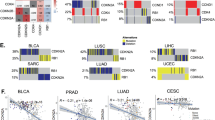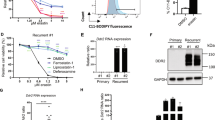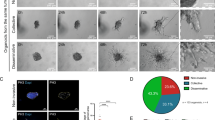Abstract
The processes that control the progression of ductal carcinoma in situ (DCIS) to invasive breast cancer remain poorly understood. Epidermal growth factor receptor 2 (ErbB2) overexpression is common in DCIS, as is disruption of the retinoblastoma tumor suppressor (RB) pathway. Here, we examined the cooperative impact of ErbB2 and RB deregulation on facets of disease progression. Our studies demonstrate that RB deficiency altered the expression of key molecules needed for proper cellular organization and epithelial cell–cell adhesion as part of a program related to the epithelial-to-mesenchymal transition (EMT). An increase in the invasive potential of ErbB2-overexpressing cells was observed upon RB depletion. Further, stable knockdown of RB resulted in invasive lesions in orthotopic xenograft assays, compared with DCIS-like lesions developing from RB-proficient cells. Conversely, the invasive phenotype observed in ErbB2-positive cancer models was inhibited through CDK4/6 inhibition in an RB-dependent manner. Finally, in a cohort of DCIS cases, we show that, although elevated levels of ErbB2 are associated with increased risk of a subsequent DCIS recurrence, it is not associated with progression to invasive disease. In contrast, RB loss in ErbB2-positive DCIS cases was associated with increased risk for invasive breast cancer. Taken together, these data demonstrate a key role for the RB pathway in invasion associated with breast tumor progression, and shed light on the key molecular events that promote the progression of DCIS to invasive disease.
This is a preview of subscription content, access via your institution
Access options
Subscribe to this journal
Receive 50 print issues and online access
$259.00 per year
only $5.18 per issue
Buy this article
- Purchase on Springer Link
- Instant access to full article PDF
Prices may be subject to local taxes which are calculated during checkout







Similar content being viewed by others
References
Ernster VL, Ballard-Barbash R, Barlow WE, Zheng Y, Weaver DL, Cutter G et al. Detection of ductal carcinoma in situ in women undergoing screening mammography. J Natl Cancer Inst 2002; 94: 1546–1554.
Virnig BA, Tuttle TM, Shamliyan T, Kane RL . Ductal carcinoma in situ of the breast: a systematic review of incidence, treatment, and outcomes. J Natl Cancer Inst 2010; 102: 170–178.
Betsill WL Jr, Rosen PP, Lieberman PH, Robbins GF . Intraductal carcinoma. Long-term follow-up after treatment by biopsy alone. Jama 1978; 239: 1863–1867.
Carlson RW, Allred DC, Anderson BO, Burstein HJ, Carter WB, Edge SB et al. Breast cancer. Clinical practice guidelines in oncology. J Natl Compr Canc Netw 2009; 7: 122–192.
Schnitt SJ . Local outcomes in ductal carcinoma in situ based on patient and tumor characteristics. J Natl Cancer Inst Monogr 2010; 41: 158–161.
Allegra CJ, Aberle DR, Ganschow P, Hahn SM, Lee CN, Millon-Underwood S et al. National Institutes of Health State-of-the-Science Conference statement: diagnosis and management of ductal carcinoma in situ September 22-24, 2009. J Natl Cancer Inst 2010; 102: 161–169.
Jones JL . Overdiagnosis and overtreatment of breast cancer: progression of ductal carcinoma in situ: the pathological perspective. Breast Cancer Res 2006; 8: 204.
Romero L, Klein L, Ye W, Holmes D, Soni R, Silberman H et al. Outcome after invasive recurrence in patients with ductal carcinoma in situ of the breast. Am J Surg 2004; 188: 371–376.
Kerlikowske K, Molinaro A, Cha I, Ljung BM, Ernster VL, Stewart K et al. Characteristics associated with recurrence among women with ductal carcinoma in situ treated by lumpectomy. J Natl Cancer Inst 2003; 95: 1692–1702.
Knudsen ES, Ertel A, Davicioni E, Kline J, Schwartz GF, Witkiewicz AK . Progression of ductal carcinoma in situ to invasive breast cancer is associated with gene expression programs of EMT and myoepithelia. Breast Cancer Res Treat 2011; 133: 1009–1024.
Lee S, Stewart S, Nagtegaal I, Luo J, Wu Y, Colditz G et al. Differentially expressed genes regulating the progression of ductal carcinoma in situ to invasive breast cancer. Cancer Res 2012; 72: 4574–4586.
Franke WW . Discovering the molecular components of intercellular junctions—a historical view. Cold Spring Harb Perspect Biol 2009; 1: a003061.
Zhurinsky J, Shtutman M, Ben-Ze'ev A . Plakoglobin and beta-catenin: protein interactions, regulation and biological roles. J Cell Sci 2000; 113 (Pt 18): 3127–3139.
Wheelock MJ, Johnson KR . Cadherins as modulators of cellular phenotype. Annu Rev Cell Dev Biol 2003; 19: 207–235.
Rodriguez-Boulan E, Nelson WJ . Morphogenesis of the polarized epithelial cell phenotype. Science 1989; 245: 718–725.
O'Brien LE, Zegers MM, Mostov KE . Opinion: building epithelial architecture: insights from three-dimensional culture models. Nat Rev Mol Cell Biol 2002; 3: 531–537.
Kim YS, Won YS, Park KS, Song BJ, Kim JS, Oh SJ et al. Prognostic significance of HER2 gene amplification according to stage of breast cancer. J Korean Med Sci 2008; 23: 414–420.
Ross JS, Slodkowska EA, Symmans WF, Pusztai L, Ravdin PM, Hortobagyi GN . The HER-2 receptor and breast cancer: ten years of targeted anti-HER-2 therapy and personalized medicine. Oncologist 2009; 14: 320–368.
Slamon DJ, Clark GM, Wong SG, Levin WJ, Ullrich A, McGuire WL . Human breast cancer: correlation of relapse and survival with amplification of the HER-2/neu oncogene. Science 1987; 235: 177–182.
Allred DC, Clark GM, Molina R, Tandon AK, Schnitt SJ, Gilchrist KW et al. Overexpression of HER-2/neu and its relationship with other prognostic factors change during the progression of in situ to invasive breast cancer. Hum Pathol 1992; 23: 974–979.
Hoque A, Sneige N, Sahin AA, Menter DG, Bacus JW, Hortobagyi GN et al. Her-2/neu gene amplification in ductal carcinoma in situ of the breast. Cancer Epidemiol Biomarkers Prev 2002; 11: 587–590.
Muthuswamy SK, Li D, Lelievre S, Bissell MJ, Brugge JS . ErbB2 but not ErbB1, reinitiates proliferation and induces luminal repopulation in epithelial acini. Nat Cell Biol 2001; 3: 785–792.
Wu M, Jung L, Cooper AB, Fleet C, Chen L, Breault L et al. Dissecting genetic requirements of human breast tumorigenesis in a tissue transgenic model of human breast cancer in mice. Proc Natl Acad Sci USA 2009; 106: 7022–7027.
Kerlikowske K, Molinaro AM, Gauthier ML, Berman HK, Waldman F, Bennington J et al. Biomarker expression and risk of subsequent tumors after initial ductal carcinoma in situ diagnosis. J Natl Cancer Inst 2010; 102: 627–637.
Gauthier ML, Berman HK, Miller C, Kozakeiwicz K, Chew K, Moore D et al. Abrogated response to cellular stress identifies DCIS associated with subsequent tumor events and defines basal-like breast tumors. Cancer Cell 2007; 12: 479–491.
Witkiewicz AK, Rivadeneira DB, Ertel A, Kline J, Hyslop T, Schwartz GF et al. Association of RB/p16-pathway perturbations with DCIS recurrence dependence on tumor versus tissue microenvironment. Am J Pathol 2010; 179: 1171–1178.
Knudsen ES, Pajak TF, Qeenan M, McClendon AK, Armon BD, Schwartz GF et al. Retinoblastoma and phosphate and tensin homolog tumor suppressors: impact on ductal carcinoma in situ progression. J Natl Cancer Inst 2012; 104: 1825–1836.
Knudsen ES, Knudsen KE . Tailoring to RB: tumour suppressor status and therapeutic response. Nat Rev Cancer 2008; 8: 714–724.
Cobrinik D . Pocket proteins and cell cycle control. Oncogene 2005; 24: 2796–2809.
Jiang Z, Deng T, Jones R, Li H, Herschkowitz JI, Liu JC et al. Rb deletion in mouse mammary progenitors induces luminal-B or basal-like/EMT tumor subtypes depending on p53 status. J Clin Invest 2010; 120: 3296–3309.
Herschkowitz JI, He X, Fan C, Perou CM . The functional loss of the retinoblastoma tumour suppressor is a common event in basal-like and luminal B breast carcinomas. Breast Cancer Res 2008; 10: R75.
Debnath J, Muthuswamy SK, Brugge JS . Morphogenesis and oncogenesis of MCF-10A mammary epithelial acini grown in three-dimensional basement membrane cultures. Methods 2003; 30: 256–268.
Hebner C, Weaver VM, Debnath J . Modeling morphogenesis and oncogenesis in three-dimensional breast epithelial cultures. Annu Rev Pathol 2008; 3: 313–339.
Kenny PA, Lee GY, Myers CA, Neve RM, Semeiks JR, Spellman PT et al. The morphologies of breast cancer cell lines in three-dimensional assays correlate with their profiles of gene expression. Mol Oncol 2007; 1: 84–96.
Taube JH, Herschkowitz JI, Komurov K, Zhou AY, Gupta S, Yang J et al. Core epithelial-to-mesenchymal transition interactome gene-expression signature is associated with claudin-low and metaplastic breast cancer subtypes. Proc Natl Acad Sci USA 2010; 107: 15449–15454.
Petersen OW, Ronnov-Jessen L, Howlett AR, Bissell MJ . Interaction with basement membrane serves to rapidly distinguish growth and differentiation pattern of normal and malignant human breast epithelial cells. Proc Natl Acad Sci USA 1992; 89: 9064–9068.
Toogood PL, Harvey PJ, Repine JT, Sheehan DJ, VanderWel SN, Zhou H et al. Discovery of a potent and selective inhibitor of cyclin-dependent kinase 4/6. J Med Chem 2005; 48: 2388–2406.
Fry DW, Harvey PJ, Keller PR, Elliott WL, Meade M, Trachet E et al. Specific inhibition of cyclin-dependent kinase 4/6 by PD 0332991 and associated antitumor activity in human tumor xenografts. Mol Cancer Ther 2004; 3: 1427–1438.
Dean JL, Thangavel C, McClendon AK, Reed CA, Knudsen ES . Therapeutic CDK4/6 inhibition in breast cancer: key mechanisms of response and failure. Oncogene 2010; 29: 4018–4032.
Zajchowski DA, Bartholdi MF, Gong Y, Webster L, Liu HL, Munishkin A et al. Identification of gene expression profiles that predict the aggressive behavior of breast cancer cells. Cancer Res 2001; 61: 5168–5178.
Rakovitch E, Nofech-Mozes S, Hanna W, Narod S, Thiruchelvam D, Saskin R et al. HER2/neu and Ki-67 expression predict non-invasive recurrence following breast-conserving therapy for ductal carcinoma in situ. Br J Cancer 2012; 106: 1160–1165.
Correa C, McGale P, Taylor C, Wang Y, Clarke M, Davies C et al. Overview of the randomized trials of radiotherapy in ductal carcinoma in situ of the breast. J Natl Cancer Inst Monogr 2010; 41: 162–177.
Erbas B, Provenzano E, Armes J, Gertig D . The natural history of ductal carcinoma in situ of the breast: a review. Breast Cancer Res Treat 2006; 97: 135–144.
Leonard GD, Swain SM . Ductal carcinoma in situ, complexities and challenges. J Natl Cancer Inst 2004; 96: 906–920.
Hanahan D, Weinberg RA . Hallmarks of cancer: the next generation. Cell 2012; 144: 646–674.
Cavallaro U, Christofori G . Cell adhesion and signalling by cadherins and Ig-CAMs in cancer. Nat Rev Cancer 2004; 4: 118–132.
Knudsen ES, Ertel A, Davicioni E, Kline J, Schwartz GF, Witkiewicz AK . Progression of ductal carcinoma in situ to invasive breast cancer is associated with gene expression programs of EMT and myoepithelia. Breast Cancer Res Treat 2011; 133: 1009–1242 2.
Sutherland RL, Musgrove EA . Cyclins and breast cancer. J Mammary Gland Biol Neoplasia 2004; 9: 95–104.
Rivadeneira DB, Mayhew CN, Thangavel C, Sotillo E, Reed CA, Grana X et al. Proliferative suppression by CDK4/6 inhibition: complex function of the retinoblastoma pathway in liver tissue and hepatoma cells. Gastroenterology 2010; 138: 1920–1930.
Thangavel C, Dean JL, Ertel A, Knudsen KE, Aldaz CM, Witkiewicz AK et al. Therapeutically activating RB: reestablishing cell cycle control in endocrine therapy-resistant breast cancer. Endocr Relat Cancer 2011; 18: 333–345.
Knudsen ES, Buckmaster C, Chen TT, Feramisco JR, Wang JY . Inhibition of DNA synthesis by RB: effects on G1/S transition and S-phase progression. Genes Dev 1998; 12: 2278–2292.
Sotgia F, Williams TM, Schubert W, Medina F, Minetti C, Pestell RG et al. Caveolin-1 deficiency (-/-) conveys premalignant alterations in mammary epithelia, with abnormal lumen formation, growth factor independence, and cell invasiveness. Am J Pathol 2006; 168: 292–309.
Storey JD . A direct approach to false discovery rates. J R Stat Soc 2002; 64: 479–498.
Hackstadt AJ, Hess AM . Filtering for increased power for microarray data analysis. BMC Bioinformatics 2009; 10: 11.
Subramanian A, Tamayo P, Mootha VK, Mukherjee S, Ebert BL, Gillette MA et al. Gene set enrichment analysis: a knowledge-based approach for interpreting genome-wide expression profiles. Proc Natl Acad Sci USA 2005; 102: 15545–15550.
McClendon AK, Dean JL, Ertel A, Fu Z, Rivadeneira DB, Reed CA et al. RB and p53 cooperate to prevent liver tumorigenesis in response to tissue damage. Gastroenterology 2011; 141: 1439–1450.
Acknowledgements
We thank all of our colleagues who contributed to this study. This work was supported by NIH grants to ESK (RO1-CA129134 and RO1-CA137494) and AKW (RO1-CA163863).
Author information
Authors and Affiliations
Corresponding authors
Ethics declarations
Competing interests
The authors declare no conflict of interest.
Additional information
Supplementary Information accompanies this paper on the Oncogene website
Rights and permissions
About this article
Cite this article
Witkiewicz, A., Cox, D., Rivadeneira, D. et al. The retinoblastoma tumor suppressor pathway modulates the invasiveness of ErbB2-positive breast cancer. Oncogene 33, 3980–3991 (2014). https://doi.org/10.1038/onc.2013.367
Received:
Revised:
Accepted:
Published:
Issue Date:
DOI: https://doi.org/10.1038/onc.2013.367
Keywords
This article is cited by
-
Ductal carcinoma in situ of the breast: an update for the pathologist in the era of individualized risk assessment and tailored therapies
Modern Pathology (2019)
-
Targeting the RB-E2F pathway in breast cancer
Oncogene (2016)
-
Regulation of cell polarity determinants by the Retinoblastoma tumor suppressor protein
Scientific Reports (2016)
-
New Insights on COX-2 in Chronic Inflammation Driving Breast Cancer Growth and Metastasis
Journal of Mammary Gland Biology and Neoplasia (2015)



